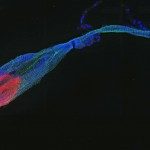Lien vers Pubmed [PMID] – 23275874
G3 (Bethesda) 2012 Dec;2(12):1505-19
Host-pathogen interactions can be powerful drivers of adaptive evolution, shaping the patterns of molecular variation at the genes involved. In this study, we sequenced alleles from 28 immune-related loci in wild samples of multiple genetic subpopulations of the African malaria mosquito Anopheles gambiae, obtaining unprecedented sample sizes and providing the first opportunity to contrast patterns of molecular evolution at immune-related loci in the recently discovered GOUNDRY population to those of the indoor-resting M and S molecular forms. In contrast to previous studies that focused on immune genes identified in laboratory studies, we centered our analysis on genes that fall within a quantitative trait locus associated with resistance to Plasmodium falciparum in natural populations of A. gambiae. Analyses of haplotypic and genetic diversity at these 28 loci revealed striking differences among populations in levels of genetic diversity and allele frequencies in coding sequence. Putative signals of positive selection were identified at 11 loci, but only one was shared by two subgroups of A. gambiae. Striking patterns of linkage disequilibrium were observed at several loci. We discuss these results with respect to ecological differences among these strata as well as potential implications for disease transmission.


